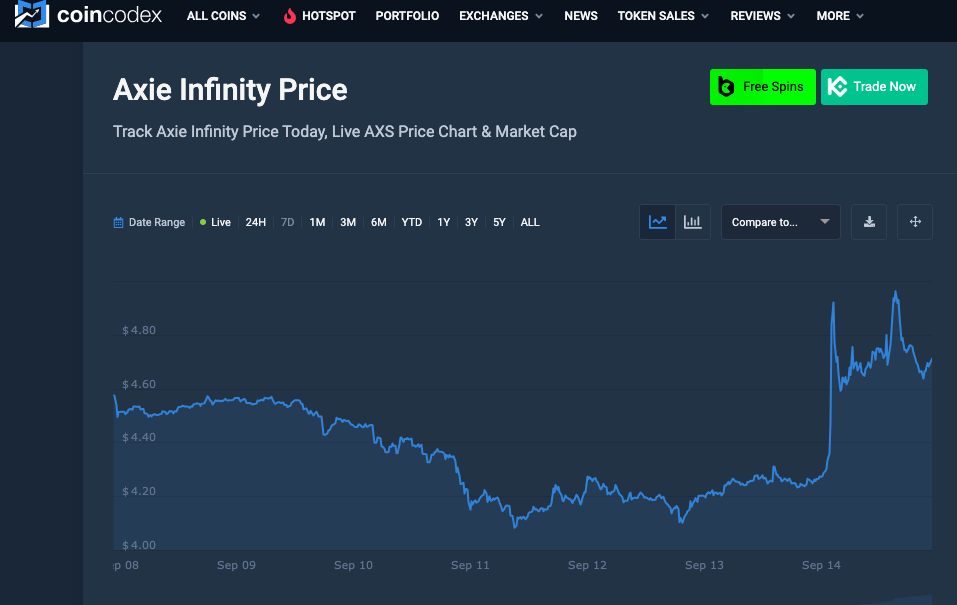Join Our Telegram channel to stay up to date on breaking news coverage
Continuing our previous highlight regarding the top altcoins for investment, we now present a new selection of assets worth considering for investment. Before entering this list, let’s review some recent financial updates.
In August, consumer prices experienced a notable increase month-over-month, marking the swiftest pace of inflation since the peak observed last year. Although the fluctuating energy costs partly drove this rise, what caught many by surprise was the unexpected acceleration of a critical gauge of underlying inflation.
A straight line can be drawn from the inflation at the consumption levels to the investment behavior and decisions in cryptocurrency. Investors are also consumers and may have to seek cheaper investment options to free up money for daily consumption.
For the above reason, we compiled a list of the 5 best altcoins to invest in.
5 Best Altcoins To Invest In Right Now
The older and more prominent names in the cryptocurrency market are expensive. They are also currently on a bear run. The situation is expected to change eventually, but the alternative tokens are ripe for the taking. Below is a list of the best five to consider adding to your portfolio.
1. Tellor (TRB)
Tellor is at the forefront of Oracle services within the blockchain ecosystem. To understand its significance, we need to grasp the role of oracles in the blockchain space. Oracles serve as bridges between the on-chain and off-chain worlds. They facilitate real-world data transfer onto the blockchain, enabling smart contracts to execute actions based on this data.
Tellor’s Oracle protocol furthers this concept by providing a decentralized, community-driven solution. Here’s how it works:
Data Requests: First, users or smart contracts on the blockchain can request specific off-chain data. This data can vary widely, from the current price of cryptocurrencies and commodities to weather information, stock prices, etc.
Data Reporting: To fulfill these data requests, Tellor relies on a network of data reporters. These individuals or entities are incentivized with TRB tokens to provide accurate data. They compete to report data, ensuring its accuracy.
Data Validation: Once the data is reported, it undergoes a validation process to confirm its accuracy. This validation is crucial because blockchain relies on trustlessness, and inaccurate data could significantly affect smart contract execution.
On-Chain Availability: The data is made available on the blockchain after validation. Smart contracts can then access this information, enabling a wide range of DeFi applications. For instance, a lending protocol might use Tellor’s oracle to determine the current price of collateral assets.
Security and Decentralization: Tellor’s system is decentralized and secured by a network of miners responsible for the data reporting and validation processes. This decentralization ensures that a single entity doesn’t control the data and is resistant to manipulation.
👇 how the tellor oracle works: pic.twitter.com/fIaTOTIGnX
— Tellor (@WeAreTellor) September 28, 2022
The TRB token plays a pivotal role in this ecosystem. It incentivizes data reporters to provide accurate information and participate in the network’s operations. Users and developers also interact with TRB when requesting data or integrating Tellor’s Oracle into their applications.
2. Axie Infinity (AXS)
Axie Infinity is an innovative blockchain-based game inspired by popular classics like Pokémon and Tamagotchi. In this immersive world, players engage in various activities centered around collecting, breeding, raising, battling, and trading adorable creatures called Axies.
What sets Axie Infinity apart is the extensive diversity and customization it offers. Players can choose from over 500 body parts spanning a range of categories, including aquatic, beast, bird, bug, plant, and reptile parts. These body parts also come in four rarity scales: common, rare, ultra rare, and legendary. Every Axie is unique, and their characteristics and strengths can vary significantly.
Each Axie is represented as a non-fungible token (NFT), making it a one-of-a-kind digital asset. Axies can form teams for thrilling 3v3 battles, where strategy and teamwork are crucial. Winning battles earns experience points (exp) that can be used to level up an Axie’s stats or even evolve their body parts, enhancing their abilities.
Breeding Axies is another exciting aspect of the game. By pairing different Axies, players can produce new offspring with their distinctive traits. These offspring can be utilized in battles, sold on the Axie marketplace, or traded with other players.
Lunacians, the Mystic Era has ended and we have now entered the Off-Season. ⚔️
Congrats to everyone who battled it out in the Arena during Season 5! We’ve released a few exciting updates for the Off-Season. Here’s what’s new! 👇 pic.twitter.com/p6PCcad47o
— Axie Infinity (@AxieInfinity) September 14, 2023
In addition to the in-game dynamics, Axie Infinity boasts its governance token known as Axie Infinity Shards (AXS). AXS tokens are more than just a digital asset; they grant players a voice in the game’s governance decisions. Holders of AXS can participate in crucial votes, influencing how funds in the Axie Community Treasury are allocated.
3. Avalanche (AVAX)
Avalanche is a prominent layer one blockchain aiming to challenge Ethereum’s dominance as the leading blockchain for smart contracts and decentralized applications. It seeks to achieve this by offering higher transaction throughput, boasting a remarkable capacity of up to 6,500 transactions per second while maintaining excellent scalability.
The key to Avalanche’s impressive performance lies in its unique architectural approach. The Avalanche network is built upon three distinct blockchains, each with a specific purpose: the X-Chain, C-Chain, and P-Chain. This design is a radical departure from the consensus mechanism employed by Bitcoin and Ethereum, where all nodes validate all transactions. Avalanche blockchains utilize different consensus mechanisms tailored to their particular use cases.
Additionally, Avalanche places a strong emphasis on interoperability. It actively works to enhance connectivity between its ecosystem and Ethereum, facilitating seamless cross-chain interactions by creating bridges and other technological solutions.
4. Bitcoin Cash (BCH)
Bitcoin Cash (BCH) is a decentralized peer-to-peer electronic cash system that aspires to establish itself as a reliable global currency. It offers swift transactions, minimal fees, enhanced privacy, and more extensive block sizes. This cryptocurrency operates without trusted intermediaries, maintaining its permissionless and decentralized nature.
Bitcoin Cash emerged as an alternative to Bitcoin (BTC), the pioneering and most valuable cryptocurrency. In 2017, BCH developers implemented modifications to the BTC code, creating their unique software version and a fully competitive product. This development led to a significant division in the Bitcoin community, splitting it into two blockchains: Bitcoin and Bitcoin Cash.
The genesis of Bitcoin Cash can be attributed to a contentious scaling debate within the community. This dispute revolved around whether to increase the block size of Bitcoin. Advocates of smaller blocks were concerned that enlarging them could potentially centralize the blockchain, making it more vulnerable to attacks and less accessible to host full nodes. Conversely, proponents of larger blocks argued for a quicker resolution to address growing transaction fees, which were seen as a potential obstacle to the network’s expansion.
15 days to go until the #BCH network upgrade! 🌟
Join us for the livestream on November 15:
– Upgrade explained 🤔
– Hashrate updates ⚡
– Live open discussion 🎙️
https://t.co/U6ckh5db6q #BitcoinCash pic.twitter.com/BgrJaJ5vxu— BitcoinCash.org (@bitcoincashorg) October 31, 2020
Notably, Bitcoin Cash experienced another hard fork in late 2018, dividing the cryptocurrency into two factions: Bitcoin ABC and Bitcoin SV.
5. Bitcoin BSC
Bitcoin BSC represents an innovative fusion of the timeless value of Bitcoin with the cutting-edge technology of the BNB Smart Chain (BSC). This integration introduces a novel staking mechanism designed to be environmentally friendly and promote long-term holding of the token. It redefines the concept of token-based rewards and participation within the cryptocurrency space.
Operating as a BEP-20 token on the BNB Smart Chain, Bitcoin BSC strongly emphasizes staking. Unlike the traditional mining process associated with Bitcoin, Bitcoin BSC offers $BTCBSC token holders the opportunity to generate passive income through staking activities. These rewards are directly linked to the number of tokens staked, echoing the original block reward mechanism of Bitcoin.
https://twitter.com/Bitcoinbsctoken/status/1699000085290369232?s=20
Bitcoin BSC’s Stake-to-Earn model is an environmentally conscious alternative to Bitcoin’s resource-intensive Proof-of-Work mechanism. This innovation aligns with Bitcoin’s historical milestones, including its estimated 120-year issuance schedule and block confirmations since April 2011.
Within the Bitcoin BSC ecosystem, staking rewards are tied directly to a participant’s stake in the staking pool and the prevailing Annual Percentage Yield (APY). This unique model fosters a decentralized and actively engaged community, ensuring the continuous expansion of the token ecosystem.
Bitcoin BSC reduces its environmental impact by incentivizing long-term holding and active participation through staking. It empowers its community members to play an integral role in the network’s growth and sustainability. It represents a remarkable evolution of the traditional Bitcoin model, ushering in a new era of eco-conscious and community-driven cryptocurrency engagement.
Read More
Best Wallet - Diversify Your Crypto Portfolio
- Easy to Use, Feature-Driven Crypto Wallet
- Get Early Access to Upcoming Token ICOs
- Multi-Chain, Multi-Wallet, Non-Custodial
- Now On App Store, Google Play
- Stake To Earn Native Token $BEST
- 250,000+ Monthly Active Users
Join Our Telegram channel to stay up to date on breaking news coverage






